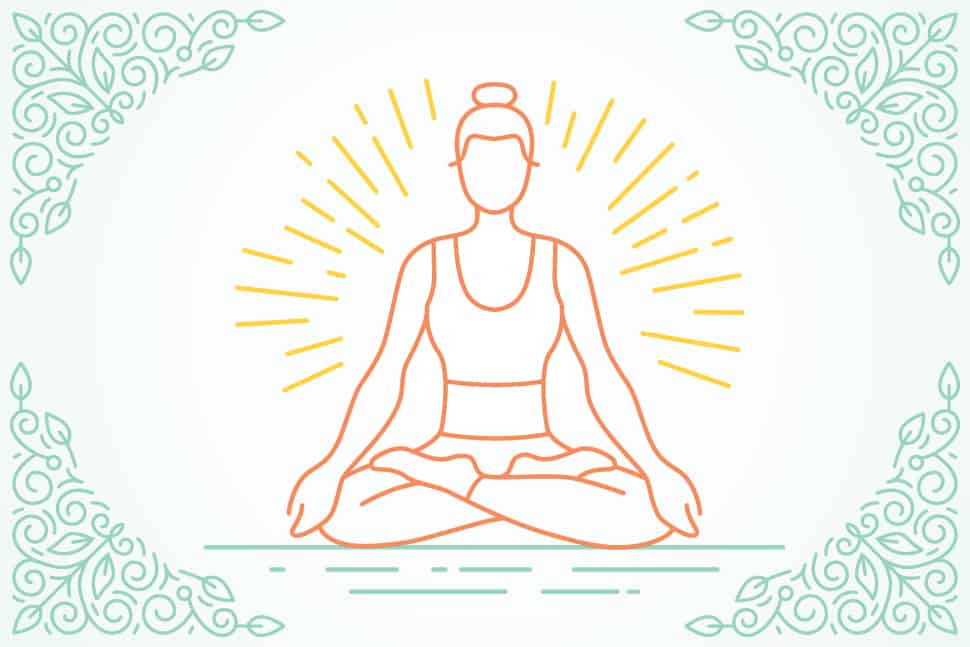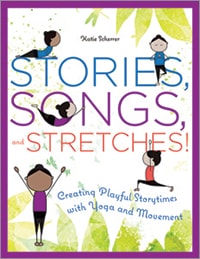
What is yoga? This seemingly straightforward question can elicit a variety of responses, depending on who you ask. Yoga may be thought of as a form of exercise, a spiritual practice, a fitness fad, a relaxation strategy, or an esoteric form of self-torture. Often, it is defined as a union of the body, heart, and mind—what we experience when these seemingly disparate parts of the self are brought together.
It may be difficult for us to remember as adults, but for young children, movement is a learning process that requires intense concentration. A child’s early physical and sensory experiences help build pathways that will shape how he or she thinks, learns, and views the world. Movement is among the brain’s top priorities. Eventually, many movements will become automatic, but before that takes place, movement overrides all other thinking activity. Put quite simply: Learning begins with the body.

Yoga provides children an opportunity to experience and practice many movements that can help them develop balance, body and spatial awareness, strength and stamina, flexibility, coordination, and control. It provides them the opportunity to move in many ways, including cross-laterally, as they use their bodies to act out stories, express emotions, and move creatively. By including yoga in storytime programs, we can help children learn how to move in a variety of ways without having to think about it. This automatic movement makes the brain more efficient, allowing children to focus more of their energy on learning the other things (such as letters and numbers) that they will need to become school ready.
Programming your yoga storytime
The design of a yoga storytime has much in common with the design of a traditional storytime program, but the reader makes intentional choices to engage children physically and emotionally. The level and amount of movement varies from program to program and presenter to presenter. There is ample room for creativity, and presenters should be enthusiastic and comfortable with the material.
A yoga storytime typically lasts 30–45 minutes. Presenters should incorporate components that they use in their other storytimes, including books, storytelling, music, rhymes, and digital tools. Within this template, they can include yoga poses and movement to the degree that they feel comfortable and that seems appropriate for the group. Pay attention to what your group needs throughout the program and adjust as needed. If you are reading a story without movement and have completely lost the group’s attention, switch gears and add in a movement song. If the group looks tired and you have a big movement story planned, lessen the amount of movement to let them rest.
Yoga classes the world over end with a brief period of relaxation, typically three to five minutes, known in Sanskrit as savasana, which translates in English to “corpse pose.” This is the time when the activity ceases and the objective is simply to rest quietly. Including a few minutes of relaxation for your group is a wonderful way to end your yoga storytime. Asking children to be quiet and still for a few moments can help them learn self-regulation.
To make this rest period appropriate for preschool-age children, keep it nice and short, approximately 30 seconds to 2 minutes. Adults typically practice this pose lying on their backs, but it is perfectly fine to encourage children to rest in any way that they feel comfortable. They may even want to use the time to cuddle up with their grown-up. You may want to play some calming music or nature sounds during this time to aid relaxation.
As the storytime leader, you should lie down and take a brief rest along with the group to reassure the children that they are not missing anything interesting. It is perfectly normal for some children to whisper, giggle, or fidget; don’t try to control this. Ring a bell or chime or use some other cue to let the group know when it is time to transition out of rest back into the remainder of the closing routine.
Selecting materials
Selecting materials for yoga storytime has much in common with the way materials are selected for any storytime program. The presenter will seek out books, songs, and digital media that are fun to share with young children.
When using books in a yoga storytime setting, you have many options for how and when to incorporate movement and how much movement to incorporate, including the following:
- Read the book and then, after reading, come back to a few passages to act out.
- Read the book and act out the movements as they are described.
- Read the book, act out the movements, and add yoga poses inspired by the various characters.
When selecting books, use the same criteria that you apply in all storytimes: Is the story interesting and engaging? Do the illustrations and physical design of the book present well to a group? Am I seeking out and including books by and about diverse groups of people? Can I use this book in a way that models participation in important early literacy practices?
Books that include movement within the story are a natural fit for a yoga storytime. Sometimes, movement may serve as the central theme of the story, such as in Stretch by Doreen Cronin (Atheneum Books for Young Readers, 2009). Often, various movements (such as jumping, flying, and swimming) will be paired with characters in the story.

Your individual style and the degree of movement you feel comfortable sharing will influence how you use the book. Books with animal characters are particularly well suited for use because nearly every animal imaginable can be expressed physically through a yoga pose. The animal names given to the various poses illustrate this characteristic. Some yoga poses have obvious animal-inspired origins, such as downward-facing dog and cobra pose. Other poses can be transformed into animal shapes, such as by renaming crescent moon pose as rhinoceros pose, inspired by interpreting the clasped hands above the head as a rhinoceros’s horn. The rhyme-based stories by Jane Cabrera, such as Row, Row, Row Your Boat (Holiday House, 2014), lend themselves to a natural incorporation of animal-inspired yoga poses.
Books that celebrate the natural world are also ideal for use in yoga storytime, such as Call Me Tree/Llámame árbol by Maya Christina Gonzalez (Children’s Book Press, 2014). Many yoga poses are inspired by landforms, such as mountain and tree poses. As with animal poses, traditional names for yoga poses can be reimagined to physically express different elements of the natural world.
There is a small but growing genre of yoga-inspired picture books that incorporate yoga poses directly into the stories themselves, such as Rachel’s Day in the Garden by Giselle Shardlow (CreateSpace Independent Publishing Platform, 2014). Other yoga-inspired picture books, such as The Yoga Game by the Sea by Kathy Beliveau (Simply Read Books, 2015), offer riddles that encourage readers to guess the yoga shape and then try it out for themselves.
Picture books that include messages related to yoga principles, such as peace, respect for the environment, and care for one another, are good choices that allow children to cool down from all the movement they’ve experienced throughout the program. These stories provide a natural transition from the activity of the program into the period of final relaxation.
Storytime Yoga: Teaching Yoga to Children through Story by Sydney Solis (The Mythic Yoga Studio, 2006) is a helpful resource for finding stories that have been adapted to include yoga poses and movement. In addition to presenting numerous folktales that have been modified in this way, this resource offers guidance on how to select and adapt folktales and other stories into storytelling that involves the body.
Planning logistics
Now that we’ve walked through basic yoga storytime design and the selection of books, music, and other materials, let’s clarify some logistical details.
Ages. A yoga storytime should target children who are old enough to engage in the yoga poses and movement components that your storytime will be exploring. An ideal target age for a yoga storytime is 3–6 years old. Adult caregivers should attend the storytime with their child and be encouraged to participate at their comfort level.
Registration. Because a yoga storytime is very active and requires more space for movement than other programs, you might want to require program registration in order to limit the size of the group to a workable number. If your program is set up as a limited series that requires registration rather than an ongoing program, you have the advantage of being able to introduce yoga poses and movement components that children can learn and build on from week to week. The downside is that advance registration can create a barrier to attendance for families who would be more apt to join if they could simply drop in when convenient.
Physical setup. Set up your program in a room large enough to allow adults and children to sit together in a circle on the floor so that everyone can see you. Be sure that there is enough room for the group to move through the various poses and creative movement components that you have planned for your program.
Adults are encouraged to sit with and participate with their child, but some may have a difficult time sitting on the floor for a sustained period. Have chairs available for those who need them. The room should be as free as possible of distractions that may grab the attention of young children. Have a chair or cart for your own supplies that keeps them out of the reach of young children.
Supplies. Yoga mats are not necessary for a yoga storytime. If the floor of the area where you are offering your program is uncarpeted, or if you are presenting your program outside, consider asking families to bring mats or towels to sit on, or consider providing mats. Large rolls of yoga mat material can be purchased and cut to custom sizes; this option may be more cost-effective than purchasing many individual mats. Regular-sized yoga mats can be cut in half to make smaller yoga mat squares that are an appropriate size for young children. Be aware that mats can be a tripping hazard for young children. Move the mats out of the way when you are playing games or using songs that encourage free-form running, jumping, and dancing.
Books that include movement within the story are a natural fit for a yoga storytime.
Preparing yourself
Yoga storytime is a physical program. Take the time to prepare your body by doing your own yoga practice or stretching routine. At minimum, practice in advance all the movements and yoga poses that you intend to share so that you are familiar with how they feel in your body.
A yoga storytime requires you to be especially attuned to the needs of the group you are serving. No matter what has come earlier in the day, or what is waiting for you to deal with later, a yoga storytime leader should be completely present during the program. This means being welcoming and including everyone who attends; being responsive to the needs of the group and adjusting your plans accordingly; and being able to guide the energy of the group from the warm-up stage into the most active and energetic stage and back down into the restful and relaxed stage.
You may want to spend a few moments, after you’ve set everything up for your program and before families arrive, quietly reflecting on your intention. What do you want families and children to experience or feel by participating? Allow yourself to sit quietly, watching your breathing, and set this intention for yourself.
Make it yours
As with any storytime, a variety of personal styles will influence what yoga storytime looks like in action at your library. There is no one cookie-cutter mold of programming. Your yoga storytime will be uniquely yours. Be present. Be authentic. Have fun.


